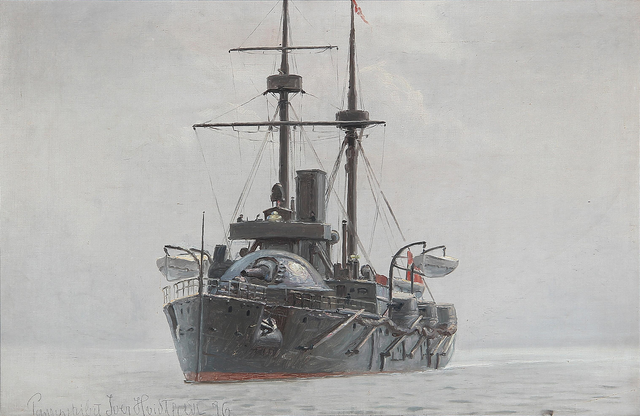
Next entry after the ram Tordenskjold. HDMS Iver Hvitfeldt was a coastal defense ship built for the Royal Danish Navy and intended for the defense of Copenhagen, small yet heavily armed and well protected with two 260 mm (10.2 in) guns in barbette mounts fore and aft. Her career was however quiet, between routine training exercises and a few goodwill visits in northern Europe. In 1904 she burned completely, but was repaired and modernized and spent the first world war reinforcing Danish neutrality stance, albeit in reserve. By 1919, she had been a barracks ship when sold for BU in 1919, scrapped not far away in the Netherlands.
Development
Denmark saw a decline of naval rank after the devastating Battle of Copenhagen and by the 1880s was essentually a minor coastal defense force, focusing of deterrence against its neighbor, starting with Imperial Germany, fuelled by its conflicting past with Prussia. In the decade after 1860, Denmark purchased or built eight ironclad warships, coastal defense ships and scrapped its fleet of wooden steam frigates in order to face a possible new conflict with what was now the German Empire. These coastal vessels were part of an integrated coastal defense system based around the island of Zealand, and surrounding shore forts protecting Copenhagen Bay. It was completed by spar torpedo boats to attack by night a blockading fleet, coastal artillery, and mines. In 1880 she fleet had still the old broadside ironclads Dannebrog, Peder Skram, Danmark, and the armoured coast defence ships Rolf Krake, Lindormen, Gorm, Odin and the new Helgland in contruction (she was launched in 1870).
However this heterogeneous “park” was now ageing. A naval law passed in May 1880 to establish a fleet of eight ironclads, four cruisers, ten corvettes as well as schooners and gunboats plus twelve ironclad gunboats and thirty torpedo boats, which just made an appareance in all fleets. The Helgoland was a step towards a standard of coast defence ship, with 5300 tonnes in displacement, 13 knots and one massive turreted 305 mm (12 inches) gun. Some considered her too costly and heavy for a serie and looked towards a smaller type.
Thus navy’s designers at Orlogsværftet started work on a proposal for a smaller, cheaper but more versatile coastal defense ship, able to replace with her sisters the oldest ironclads. It was somewhat based on Helgoland but much reduced and with many modifications. Indeed despite the plan being voted, budgetary constraints prevented the construction of sister ships of Helgoland, and by 1880 she she was to be started, funds available were redirected on the new unprotected cruiser HDMS Fyen.
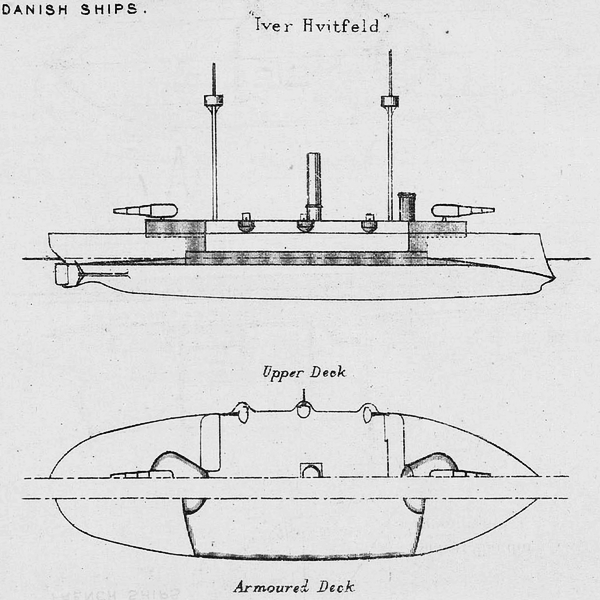
Brassey’s depiction in 1895
The design of Iver Hvitfeldt was thus not approved by the MoD until 27 June 1883 and she eventually incorporated foreign design ideas. The staff looked as Helgoland’s protection obsolete and inadequate against the latest shells, and wanted an armor capable of defeating new armor-piercing shells. Instead of a single, massive, slow firing gun, they looked at a faster-firing and more balanced artillery and if possible, a better top speed, all this on a measured displacement, possibly 2,000 tonnes less. This limited displacement call for sacrifices, notably dropping the full waterline belt and concentrating protection in the central section with a thinner but curved armor, extended to the bow and stern. The central citadel was designed to keep buoyancy and thus the ship afloat even with her bow and stern flooded, a principle taken from British ironclads.
In the end the design was approved and she was ordered to Orlogsværftets in København (Copenhaguen), laid down 9.4.1884, launched on 14.4.1886 and completed 1.6.1887. So she was built in three years, without major incident or delay.
Design of the class
Hull and general design
Iver Hvitfeldt (a XVIIIth c. admiral, participant of the the Battle of Hogue with the NL Navy) was built from a steel hull, 74 m (242 ft 9 in) long between perpendiculars and with a beam of 15.11 m (49 ft 7 in) maximum draft of 5.59 m (18 ft 4 in). The ratio was 5:1, best for agility not for speed. She was not only smaller but also lighter than the previous helgoland at 3,392 long tons (3,446 t) as designed. The full crew was 277 officers and enlisted men as seen in most publications.
She was symmetrical, wit two equal masts and main guns fore and aft, and central single funnel. Superstructures were reduced to the minimum. She was modern for her time with central heating and electric lights and fitted with no less than six 400 mm (15.7 in) searchlights, two on the bridge (above the conning tower) and the remainder on the two pole masts and upper deck. As it was often the case at the time, as a popular trend, she was to be equipped with small torpedo boats, Nr. 8 and Nr. 9 built by Thornycroft and similar to those made for HMS Vulcan, RN’s first and only torpedo boat carrier. They were lowered by a steam winch and large boom, but past 1890 the idea was dropped as they were too affected by even moderate seas to work properly.
Protection
Iver Hvitfeldt had compound armor, manufactured by Cammell Laird in Britain.
Belt armor: 292 mm (11.5 in) thick, central amidships 50% lenght between barbettes.
Belt comppsition: 314 mm (12.4 in) of teak, and 2x 13 mm (0.51 in) steel for the inner skin.
Belt size: 50 m (164 ft), 6 ft 6 in (1.98 m) wide, top to bottom.
Belt’s Vertical extension: From 0.4 m (1 ft 4 in) above the waterline, 0.6 m (2 ft) below, then tapared down to 50%.
Outer belt extension: 0.78 m (2 ft 7 in) down the hull.
Armored bulkheads: Curved and 240 mm (9.4 in) thick, connecting both ends.
Armor Deck composition: Citadel bottom, 54 mm (2.1 in) thick flat, connected with top edge of the belt.
Outer citadel: Curved armor deck below the waterline, bow and stern.
Forward deck: Sloped downward toward the bow and supporting the ram.
Underwater subdivision: Bow and stern, 55 watertight compartments.
Machinery subdivision: Boilers divided into four boiler rooms.
Main battery barbettes: 216 mm (8.5 in) on top of teak planking, inner liner 11 mm (0.43 in) steel.
Barbettes steel hoods: 40 mm (1.6 in) thick.
Conning tower: 115 mm (5 in) compound armor, 38 mm (1.5 in) steel plate.
Armored tube: Below with telegraph wires, speaking tubes, helm control cables, same.
Powerplant
Iver Hvitfeldt’s propulsion revolved around two shaft propellers, four bladed bronze, powered by a pair of two-cylinder, compound steam engines manufactured by Danish shipyard own engineering firm Burmeister & Wain. They were fed by high pressure steam coming from eight coal-fired boilers, vented through a single funnel. This combination was rated for 5,100 indicated horsepower (3,800 kW), and the contracted speed was top speed of 15.25 knots (28.24 km/h; 17.55 mph). With 290 long tons (290 t) of coal carried, her radius of action was probably below 1,200 nautical miles (unknown figure) which was coherent with restricted waters and her defensive nature. Other sources gave as much as 1,600 nautical miles (3,000 km; 1,800 mi) at 9 knots (17 km/h; 10 mph).
Armament

Main Battery
The main battery comprised two Krupp 263 mm (10.2 in) 35-caliber guns C/86. They were placed fore and aft in pear-shaped barbette mounts, and fitted on top with thin steel hoods (see the thickness above) to protect gun crews from shrapnel, but not from a direct hit. Rate of fire was very slow, one shot every four minutes due to the loading procedure, the gun neeed to be laid horizontally and traversed to the right angle, and each time placed to the correct bearing and elevation. Total supply of ammunition for both was 75 shells. Best paper range was 9,500 m (31,200 ft), but effective way below. Both guns were entirely manually operated and loaded with cranks and handwheels. The arc of fire for and aft was 248 degrees, and they traversed at 90 degrees in 40 seconds to almost two minutes for the compete arc.
Secondary Battery
The secondary battery comprised four Krupp 120 mm (4.7 in) RK 30-caliber guns mounted in sponsons on all four corners of the central superstructure. They had light gun shields only sufficient to protect against anti-personnel fire, not shrapnel, so probably around 6-7 mm. Range was 7,900 m (25,900 ft), rate of fire one shot every 1.5 minutes or 90 sec. In total they were provided with 400 shells, all HE types.
Light Battery
They had two 57 mm (2.2 in) L/44 Hotchkiss guns M.1885 in sponsons, located between the 120 mm guns. Range was 7,000 m (23,000 ft), rate of fire ten shots per minute. Each had 300 shells in reserve.
This was rounded for even closer range defense by eight 1-pounder Hotchkiss revolver cannons Model 1875. Basically 6-barreled 37 mm gatling style ordnance.
Torpedo Tubes
They had four torpedo tubes, two 356 mm (14 in) Whitehead on each broadside and the 381 mm (15 in) whitehead in the bow and stern, forming a lozenge. Only the bow tube was submerged.
⚙ specifications 1887 |
|
| Displacement | 74 x 15.11 x 5.59 (242 ft 9 in x 49 ft 7 in x 18 ft 4 in) |
| Dimensions | 3,392 long tons (3,446 t) |
| Propulsion | 2 props, 2 cyl. Compound SE, 8 boilers: 5,100 ihp (3,800 kW) |
| Speed | 15.25 knots (28.24 km/h; 17.55 mph) |
| Range | coal 290t, 1,600 nm |
| Armament | 2× 26 cm, 4× 12 cm, 2× 57 m Hotchkiss, 8× Hotchkiss revolver, 2× 381, 2× 356 mm TTs |
| Protection | 180 to 290 mm (7 to 11.5 in) 220 mm (8.5 in) |
| Crew | 277 |
Career of HDMS Iver Hvitfeldt
Early Career
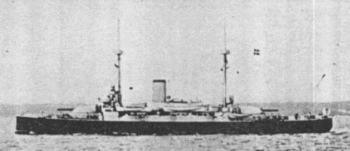 Iver Hvitfeldt (modern Huitfeldt) had her keel laid at Orlogsværftet shipyard on 9 April 1884 and she was launched on 14 April 1886, and completed her sea trials before being commissioned on 1 June 1887. She spent most of her long career in reserve, only activated in May-June for an annual training until September-October. She also cruised independently with yearly mobilized cruises and practice maneuvers, before squadron exercises. By July 1890, she led the summer training squadron under Rear Admiral Bragg (corvette St Thomas, protected cruiser Valkyrien, three TBs) for the good will visit to Britain.
Iver Hvitfeldt (modern Huitfeldt) had her keel laid at Orlogsværftet shipyard on 9 April 1884 and she was launched on 14 April 1886, and completed her sea trials before being commissioned on 1 June 1887. She spent most of her long career in reserve, only activated in May-June for an annual training until September-October. She also cruised independently with yearly mobilized cruises and practice maneuvers, before squadron exercises. By July 1890, she led the summer training squadron under Rear Admiral Bragg (corvette St Thomas, protected cruiser Valkyrien, three TBs) for the good will visit to Britain.
In 1893 she visited Trondheim and by July 1896, Sheerness and Gravesend, each time with Valkyrien. She was present for the naval review after the marriage of Prince Carl of Denmark to Maud of Wales. She also trained with the cruisers Gejser and Absalon generally in August. She was dry-docked and modernized a first time in 1898–1899. In 1899 she visited Kiel. She also led the squadron (Valkyrien, Gejser, Hjälperin, 4 TBs) in exercizes.
While laid up after the 1903 training year, she caught fire on 18 December, and completely devastated before the fire could be put out. Laird Clowes saw her at the time and reported she was “probably beyond repair”. An enquiry linked the fire later to in her coal bunkers and the summer’s heat. But instead of having disposed of it was descided to rebuilt her by early 1904, replacing her teak backing with steel or iron. She was also modernized again, armament updated (see below): 356 mm torpedo tubes removed, half Hotchkiss revolvers replaced by 6-podr guns. She was recommissioned on 2 June 1904, nothing short of an accomplishment. That way she did not missed this year’s training.
Upgrades
-In 1890 she received Bullivant anti-torpedo nets to protect her against TBs at anchorage.
-In 1894, the torpedo boats were landed, exchanged for steam barges usable for landing parties with a 1-pdr revolver cannon and spar torpedo.
-In 1897, six 1-pounder revolver cannons were added and two 1-pdr automatic guns, two 8 mm (0.31 in) machine guns.
-In 1899-1900 her original searchlights were replaced by just two 900 mm (35 in) searchlights on platforms on each mast, plus wireless telegraphy.
-In 1904, she lost her two remaining 356 mm torpedo tubes and anti-torpedo nets.
-In 1906–1907 her 120 mm guns were removed. She received eight 57 mm guns for ten total.
-In 1910 she had four 57 mm guns transferred to Skjold
-In 1912, the remaining six were eschanged for 47 mm (1.9 in) guns.
-By 1916 she was in reserve as harbour defence ship, keeping only her main guns, all others removed.
Late service 1907-1919
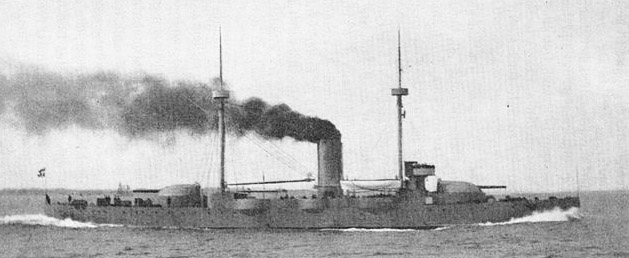
She had more refits in 1906-07 and became the sold ironclad active in the 1907 training year. She visited Rotterdam and met at Helsingør on 21 August the ship of King Frederick VIII of Denmark after a cruise to the Faroe Islands, escorted her back to Copenhagen. She was not activated in 1908, placed in the reserve fleet in 1909 but mobilized in August 1914, remaining moored at the Orlogsværftet, still in reserve and partially disarmed. In 1918 she became a barracks ship until stricken on 26 February 1919, sold to ship breakers, to a Dutch company of Rotterdam and towed there on July 1919.
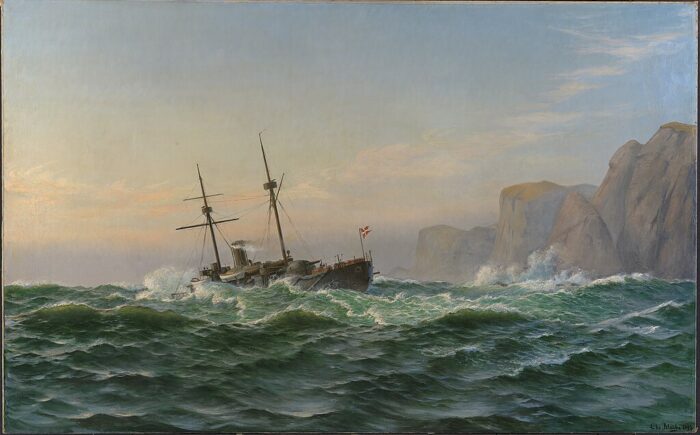
Read More/Src
Books
Anderson, R. C., ed. (1914). The Naval Pocket-Book. London: W. Thacker & Co.
Campbell, N. J. M. (1979). Gardiner, Robert; Chesneau. Conway’s All the World’s Fighting Ships 1860–1905.
Colwell, J. C. (1885). “Ships”. Papers on Naval Operations 1885. Government Printing Office.
“Foreign Items of Interest”. Army and Navy Journal: Gazette of the Regular and Volunteer Forces. XLI (23). 6 February 1904.
Garbett, H., ed. (March 1899). “Naval Notes: Denmark”. Journal of the RUSI XLIII (253). Keliher & Co.
James, Reginald W., ed. (July 1919). “Foreign and Colonial Notes”. Marine Engineer and Naval Architect. Offices for Advertisements and Publication.
“Naval and Military Notes: Denmark”. Journal of the Royal United Service Institution. XXXIX (214). J. J. Keliher & Co.
“Naval Summary”. Monthly Journal Devoted to All Subjects Connected with Her Majesty’s Land and Sea Forces. VI. W. H. Allen & Co. 1890.
Robinson, C. N.; Leyland, John (1907). “List of British and Foreign Ships”. Naval Annual. J. Griffin & Co.
Steensen, Robert Steen (2018) [1968]. Vore Panserskibe 1863–1943. Strube.
Conway’s All the World’s Fighting Ships 1906–1921.
Links
web.archive.org/ on navalhistory.dk/
on en.wikipedia.org/ HDMS_Iver_Hvitfeldt_(1886)
on navypedia.org/
on da.wikipedia.org/
Videos
None
Model Kits
None
3D
Nothing

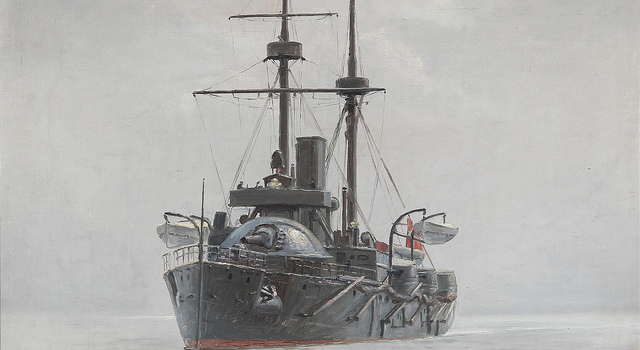

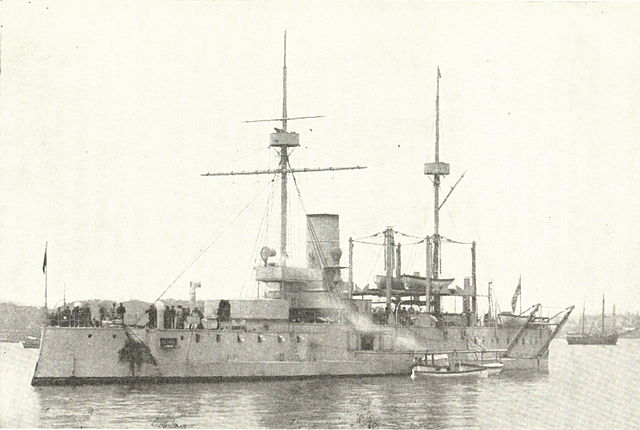


 Latest Facebook Entry -
Latest Facebook Entry -  X(Tweeter) Naval Encyclopedia's deck archive
X(Tweeter) Naval Encyclopedia's deck archive Instagram (@navalencyc)
Instagram (@navalencyc)





 French Navy
French Navy Royal Navy
Royal Navy Russian Navy
Russian Navy Armada Espanola
Armada Espanola Austrian Navy
Austrian Navy K.u.K. Kriegsmarine
K.u.K. Kriegsmarine Dansk Marine
Dansk Marine Nautiko Hellenon
Nautiko Hellenon Koninklije Marine 1870
Koninklije Marine 1870 Marinha do Brasil
Marinha do Brasil Osmanlı Donanması
Osmanlı Donanması Marina Do Peru
Marina Do Peru Marinha do Portugal
Marinha do Portugal Regia Marina 1870
Regia Marina 1870 Nihhon Kaigun 1870
Nihhon Kaigun 1870 Preußische Marine 1870
Preußische Marine 1870 Russkiy Flot 1870
Russkiy Flot 1870 Svenska marinen
Svenska marinen Søværnet
Søværnet Union Navy
Union Navy Confederate Navy
Confederate Navy Armada de Argentina
Armada de Argentina Imperial Chinese Navy
Imperial Chinese Navy Marinha do Portugal
Marinha do Portugal Mexico
Mexico Kaiserliche Marine
Kaiserliche Marine 1898 US Navy
1898 US Navy Sovietskiy Flot
Sovietskiy Flot Royal Canadian Navy
Royal Canadian Navy Royal Australian Navy
Royal Australian Navy RNZN Fleet
RNZN Fleet Chinese Navy 1937
Chinese Navy 1937 Kriegsmarine
Kriegsmarine Chilean Navy
Chilean Navy Danish Navy
Danish Navy Finnish Navy
Finnish Navy Hellenic Navy
Hellenic Navy Polish Navy
Polish Navy Romanian Navy
Romanian Navy Turkish Navy
Turkish Navy Royal Yugoslav Navy
Royal Yugoslav Navy Royal Thai Navy
Royal Thai Navy Minor Navies
Minor Navies Albania
Albania Austria
Austria Belgium
Belgium Columbia
Columbia Costa Rica
Costa Rica Cuba
Cuba Czechoslovakia
Czechoslovakia Dominican Republic
Dominican Republic Haiti
Haiti Hungary
Hungary Honduras
Honduras Estonia
Estonia Iceland
Iceland Eire
Eire Equador
Equador Iran
Iran Iraq
Iraq Latvia
Latvia Liberia
Liberia Lithuania
Lithuania Mandchukuo
Mandchukuo Morocco
Morocco Nicaragua
Nicaragua Persia
Persia San Salvador
San Salvador Sarawak
Sarawak Uruguay
Uruguay Venezuela
Venezuela Zanzibar
Zanzibar Warsaw Pact Navies
Warsaw Pact Navies Bulgaria
Bulgaria Hungary
Hungary

 Bundesmarine
Bundesmarine Dutch Navy
Dutch Navy Hellenic Navy
Hellenic Navy Marina Militare
Marina Militare Yugoslav Navy
Yugoslav Navy Chinese Navy
Chinese Navy Indian Navy
Indian Navy Indonesian Navy
Indonesian Navy JMSDF
JMSDF North Korean Navy
North Korean Navy Pakistani Navy
Pakistani Navy Philippines Navy
Philippines Navy ROKN
ROKN Rep. of Singapore Navy
Rep. of Singapore Navy Taiwanese Navy
Taiwanese Navy IDF Navy
IDF Navy Saudi Navy
Saudi Navy Royal New Zealand Navy
Royal New Zealand Navy Egyptian Navy
Egyptian Navy South African Navy
South African Navy






























 Ukrainian Navy
Ukrainian Navy dbodesign
dbodesign